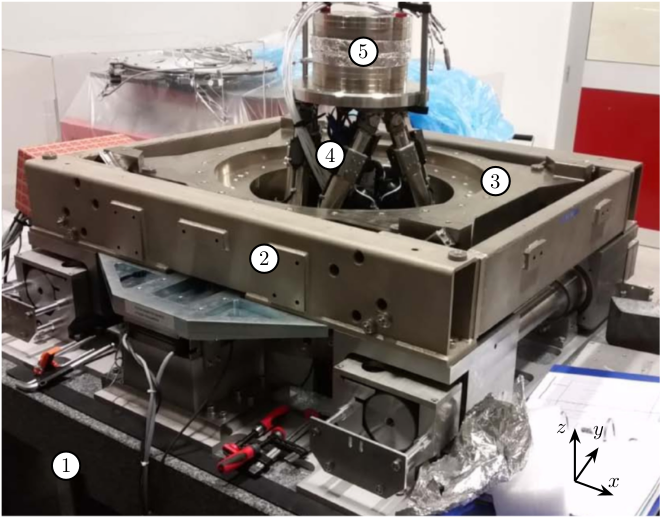Modal Analysis of the ID31 Micro-Station
The goal is to experimentally extract a Spatial Model (mass, damping, stiffness) of the structure (shown on figure 1) in order to tune the Multi-Body model.

Figure 1: Picture of the ID31 Micro-Station. (1) Granite (2) Translation Stage (3) Tilt Stage (4) Hexapod (5) Dummy Mass
The procedure is represented on figure 2 where we go from left to right.

Figure 2: Vibration Analysis Procedure
The steps are:
- we obtain a Response Model (Frequency Response Functions) from measurements (described here)
- the response model is further converted into a Modal Model (Natural Frequencies and Mode Shapes) (described here)
- this is converted into a Spatial Model with the Mass/Damping/Stiffness matrices (described here)
Theses matrices will be used to tune the Simscape (multi-body) model.
The modes we want to identify are those in the frequency range between 0Hz and 150Hz.
| Symbol | Meaning | Value |
|---|---|---|
| \(p\) | Number of solid body considered | 6 |
| \(m\) | Number of accelerometers | 23 |
| \(n\) | Number of identified modes | 21 |
| \(q\) | Number of frequency points | 801 |
| \(s\) | Number of excitation | 3 |
| Symbol | Meaning |
|---|---|
| \([\Lambda]\) | Complex eigen value matrix |
| \([\Psi]\) | Complex eigen vector matrix |
| \(\omega_r\) | Eigen frequency of mode \(r\) [rad/s] |
| \(\xi_r\) | Modal damping for mode \(r\) |
| \(\{\psi\}_r\) | Complex mode shape of mode \(r\) |
| \([M], [C], [K]\) | Mass, damping and stiffness matrices |
| \(a_r\) | "Modal A" for mode \(r\) |
The modal analysis of the ID31 Micro-station thus consists of several parts:
- Frequency Response Measurements
- Frequency Response Analysis and Processing
- Modal Parameter Extraction
- Derivation of Mathematical Model

Figure 3: Modal Anslysis Procedure